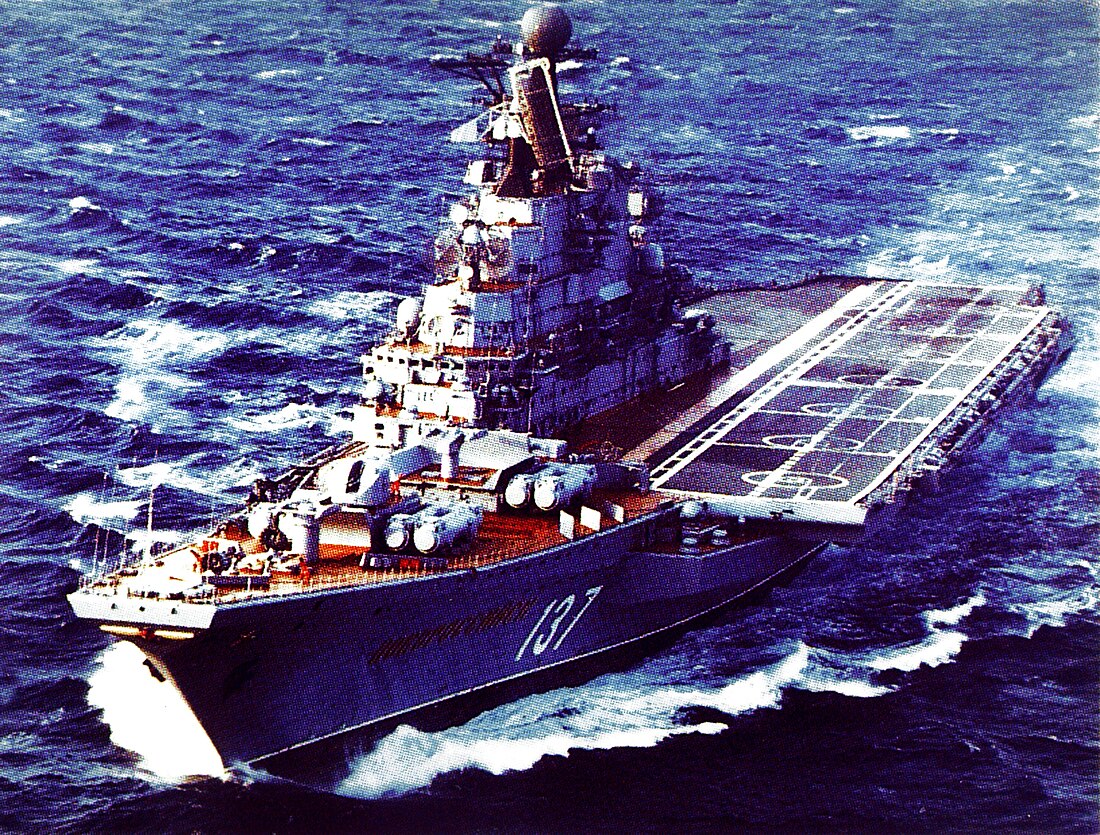Kiev-class aircraft carrier
Class of aircraft carriers built for Soviet navy From Wikipedia, the free encyclopedia
The Kiev class, Soviet designation Project 1143 Krechyet (gyrfalcon), was the first class of fixed-wing aircraft carriers (heavy aircraft cruiser in Soviet classification) built in the Soviet Union for the Soviet Navy.[1]
This article includes a list of general references, but it lacks sufficient corresponding inline citations. (January 2013) |
 Novorossiysk in 1986 | |
| Class overview | |
|---|---|
| Name | Kiev class |
| Builders | Chernomorsky Shipyard 444 |
| Operators | |
| Preceded by | Moskva class |
| Succeeded by |
|
| Subclasses | Baku class |
| Built | 1970–1987 |
| In service |
|
| Completed | 4 |
| Active | 1 |
| Preserved | 2 |
| General characteristics | |
| Type | Aircraft cruiser/Aircraft carrier |
| Displacement | 42,000–45,000 tons full load |
| Length | 273 m (895 ft 8 in) |
| Beam | |
| Draught | 10 m (32 ft 10 in) |
| Propulsion | 8 turbopressurized boilers, 4 steam turbines (200,000 shp (150,000 kW)), four shafts |
| Speed | 32 knots (59 km/h; 37 mph) |
| Complement | 1,200 to 1,600 |
| Armament |
|
| Aircraft carried |
|
| Aviation facilities | Abbreviated angled aft flight deck |
History
Summarize
Perspective
Laid down in 1970, the lead ship of the class, Kiev, was partially based on a design for a full-deck aircraft carrier proposed in Project Orel. Originally, the Soviet Navy wanted a supercarrier similar to the American Kitty Hawk class, but the smaller Kiev-class design was chosen because it was considered more cost-effective.
Unlike most NATO aircraft carriers, such as U.S. or most British ones, the Kiev class is a combination of both a cruiser and an aircraft carrier.[2][3] In the Soviet Navy, this class of ships was specifically designated as a "heavy aviation cruiser" (Russian: Тяжелые авианесущие крейсера) rather than solely as an aircraft carrier.[2] As these were not true aircraft carriers, they were permitted to transit the Turkish Straits; the 1936 Montreux Convention prohibited aircraft carriers heavier than 15,000 tons from passing through.
The ships were designed with a large island superstructure to starboard, with an angled flight-deck two-thirds of the length of the total deck; the foredeck was taken up with heavy surface-to-air and surface-to-surface missile armament. The intended mission of the Kiev class was support for ballistic missile submarines, other surface ships, and naval aviation; it was capable of engaging in anti-aircraft, anti-submarine, and surface warfare.[2]
The Soviet Union built and commissioned a total of four Kiev-class carriers, which served in the Soviet and then the Russian navies.[2] The first two ships were sold to China as museum ships, and the third ship was scrapped. The fourth ship, Admiral Gorshkov, was sold to the Indian Navy in 2004, and after years of extensive modifications and refurbishment, is in active service as INS Vikramaditya.[4]
General characteristics
- Designer: Nevskoye Planning and Design Bureau
- Builder: Nikolayev South (formerly Chernomorsky Shipyard 444) [2][3]
- Power plant: eight turbopressurized boilers, four steam turbines (200,000 shp), four shafts
- Length: 273 m (896 ft) overall [283 m (928 ft) for Baku subgroup]
- Flight deck width: 53 m (174 ft)
- Beam: 32.6 m (107 ft)
- Displacement: 43,000–45,500 metric tons full load
- Speed: 32 knots (59 km/h; 37 mph)
- Aircraft: 26–30
- Crew: 1,200–1,600 (including air wing)
- Armament:
- Kiev and Minsk:
- 4 × twin P-500 Bazalt SSM launchers (8 missiles)
- 2 × twin M-11 Shtorm SAM launchers (72 missiles)
- 2 × twin 9K33 Osa launchers (40 missiles)
- 2 × AK-726 twin 76.2 mm AA guns
- 8 × AK-630 30 mm close-in weapon system (CIWS)
- 10 × 21" torpedo tubes
- 1 × twin SUW-N-1 FRAS Anti-Submarine Rocket launcher
- Novorossiysk:
- 4 × twin P-500 Bazalt SSM launchers (8 missiles)
- 2 × twin M-11 Shtorm SAM launchers (72 missiles)
- 2 × AK-726 twin 76.2 mm AA guns
- 8 × AK-630 30 mm CIWS
- 1 × twin SUW-N-1 FRAS antisubmarine rocket launcher
- Baku:
- 6 × twin P-500 Bazalt SSM launchers (12 missiles)
- 24 × 8-cell 9K330 Tor vertical SAM launchers (192 missiles)
- 2 × 100 mm guns
- 8 × AK-630 30 mm CIWS
- 10 × 21" torpedo tubes
- 2 × RBU-6000 antisubmarine rocket launchers
- Kiev and Minsk:
- Date deployed: [2]
- 1975 (Kiev)
- 1978 (Minsk)
- 1982 (Novorossiysk)
- 1987 (Baku)
Ships
| Name | Project No. | Namesake | Builder | Laid down | Launched | Commissioned | Fate |
|---|---|---|---|---|---|---|---|
| Kiev | 1143 | City of Kiev, Ukrainian SSR | Soviet Shipyard No. 444, Nikolayev, Ukrainian SSR | 21 July 1970 | 26 December 1972 | 28 December 1975 | Sold to a Chinese company in 1996, converted into a theme park in Tianjin since 2004. Further renovated and developed into a luxury hotel since 2014. |
| Minsk | 1143 | City of Minsk, Byelorussian SSR | 28 December 1972 | 30 September 1975 | 27 September 1978 | Sold to China as a museum, placed in naval museum in Jiangsu since 2016. Caught fire on 16 August 2024 future uncertain. | |
| Novorossiysk | 11433/1143M | City of Novorossiysk, Russian SFSR | 30 September 1975 | 26 December 1978 | 14 September 1982 | Broken up at Pohang, South Korea, in 1997 | |
| Baku subclass | |||||||
| Admiral Gorshkov (ex-Baku) |
11434 | Sergey Georgiyevich Gorshkov | Soviet Shipyard No. 444, Nikolayev, Ukrainian SSR | 17 February 1978 | 1 April 1982 | 11 December 1987 | Sold to India in 2004, in service as INS Vikramaditya |
See also
References
External links
Wikiwand - on
Seamless Wikipedia browsing. On steroids.
